North America is a continent with diverse ecosystems, from lush forests to arid deserts. The wetlands are one of this continent’s most captivating and ecologically significant habitats. These watery landscapes serve as a refuge for countless bird species, and among the most charismatic are the ducks.
North America boasts an impressive array of duck species, each with unique characteristics and adaptations. This article will explore the fascinating world of North American ducks, highlighting the diverse range of species you can encounter in this vast and varied landscape.
1. The Wood Duck (Aix sponsa)
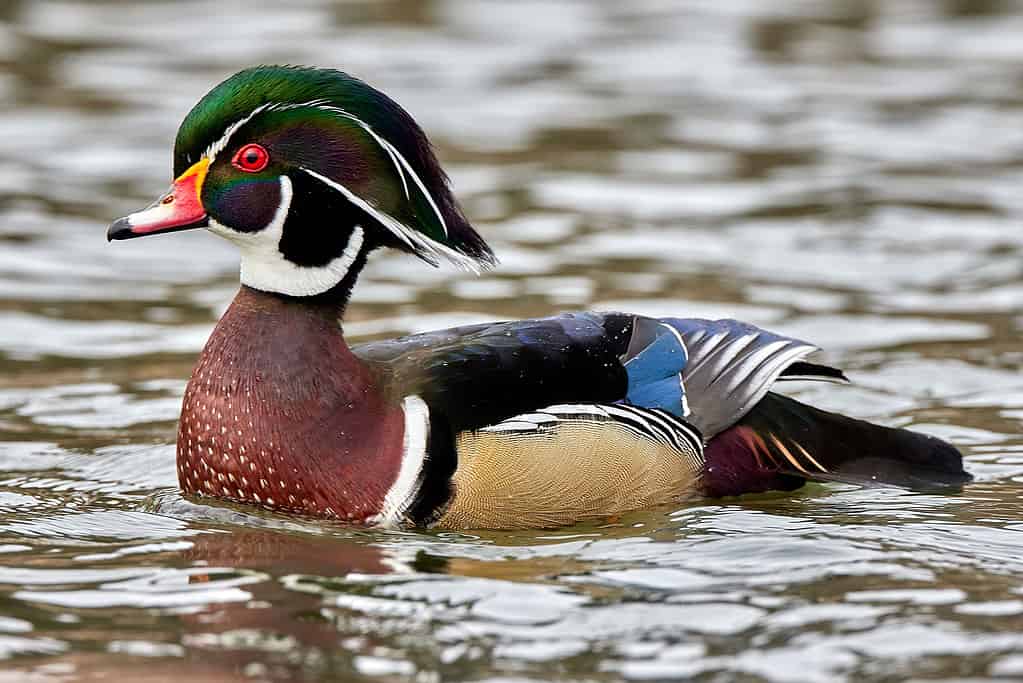
Wood ducks have one of the most unique color combinations of feathers.
©Wirestock/iStock via Getty Images
The wood duck is one of North America’s most stunning waterfowl. Males boast a mix of green and blue, a chestnut-breasted chest, and a black and white neck. The females have less vibrant colors, with tones of gray and brown and a white eye ring. Though subdued, her colors serve a significant purpose – camouflage.
The wood duck primarily lives in eastern North America, from the south of Canada to Florida. However, in recent years, their range has also extended to the Pacific Coast — from British Columbia down to the Mexican State of Baja California due to successful conservation efforts.
These ducks favor habitats lined with trees, where they nest in raised tree cavities near water. They nest off the ground to help protect their offspring from predators. They can be observed near wooded swamps, shallow lakes, marshes, and streams.
Wood ducks feed on plants, seeds, berries, aquatic insects, and other invertebrates (snails and clams). Adults can also feed on acorns during colder months, searching for them in bottomlands, flooded swamps, and oak forests.
2. The Northern Pintail (Anas acuta)
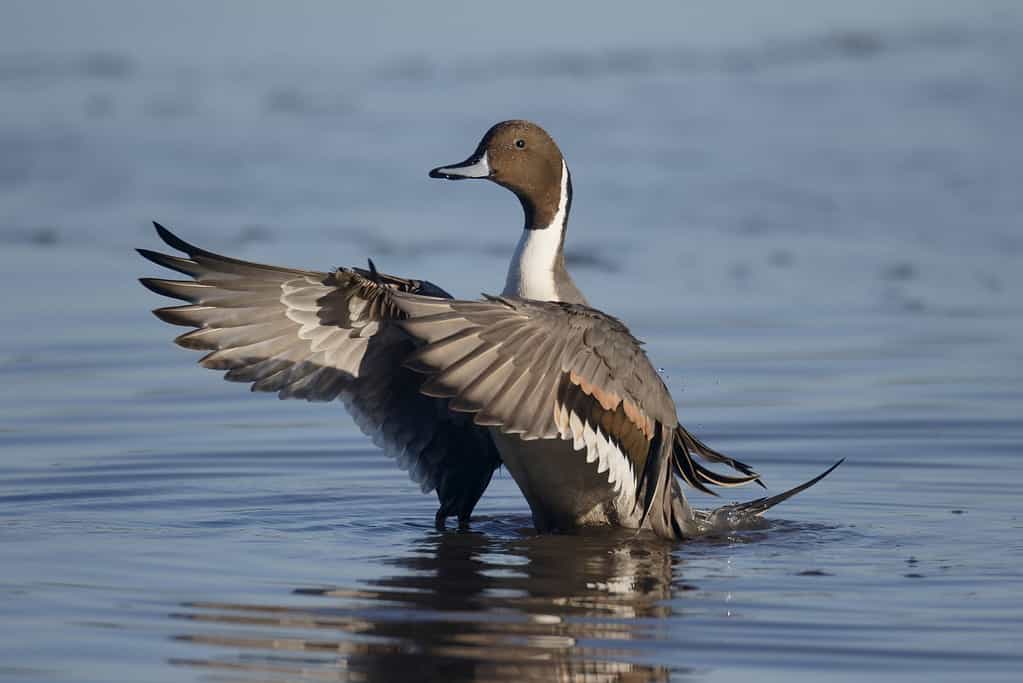
Approximately 50% of the North American population of Northern Pintails is in Alaska each summer.
©MikeLane45/iStock via Getty Images
Named for their long, pointed tail feathers, northern pintails are elegant, slender ducks. Males are known for their chocolate-brown heads, white underbellies, grayish bodies, and a distinct white stripe running down each side of their neck. Females have a subtler allure with mottled-brown feathers that afford them a remarkable camouflage amongst marshy patches of green and brown.
Commonly seen in both freshwater and saltwater habitats, their geographic distribution is wide and varied. During the summer breeding season, they are Alaska’s most common duck species. But in the winter, they prefer coastal marshes, grain fields, and freshwater across southern and central North America.
Northern pintails have various food sources and eat aquatic plant seeds, worms, snails, crustaceans, aquatic insects, and grains like barley, corn, wheat, and rice.
3. The American Teal (Anas carolinensis)
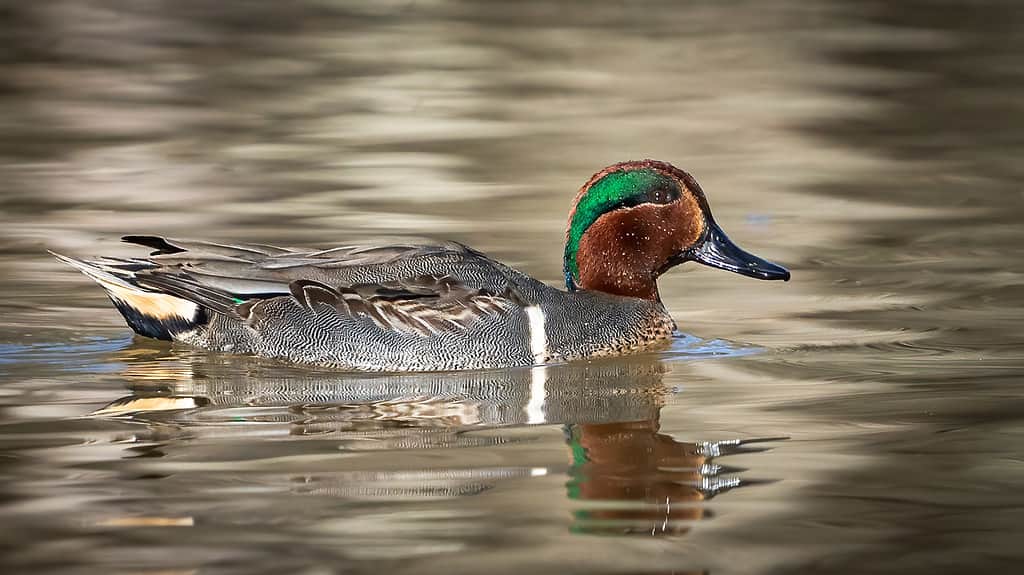
Also called the green-winged teal, it gets its name from the vibrant patch of green feathers on its head.
©William Krumpelman/iStock via Getty Images
This duck, also called the green-winged teal, is known for its swift flight, agility, and small stature. It has a distinctive mix of iridescent green and brown on its head. The rest of the body has grayish feathers with flashes of green on its wing patches.
The American teal is the smallest North American dabbling duck. Its small body allows it more control over its movement, and it can fly up to 50 mph, faster than many other duck species.
Their diet is various with aquatic vegetation, seeds, and insects. Their small size and agility make them perfect bottom feeders. They dabble just below the water’s surface for aquatic plants and invertebrates.
This species prefers life deep within the marshes, shallow lakes, and estuaries scattered across North America. They are also frequently seen resting on mudflats or secluded freshwater bodies. During winter, these speedy little ducks head south for milder climates in the southern regions of North America.
4. The Mallard (Anas platyrhynchos)
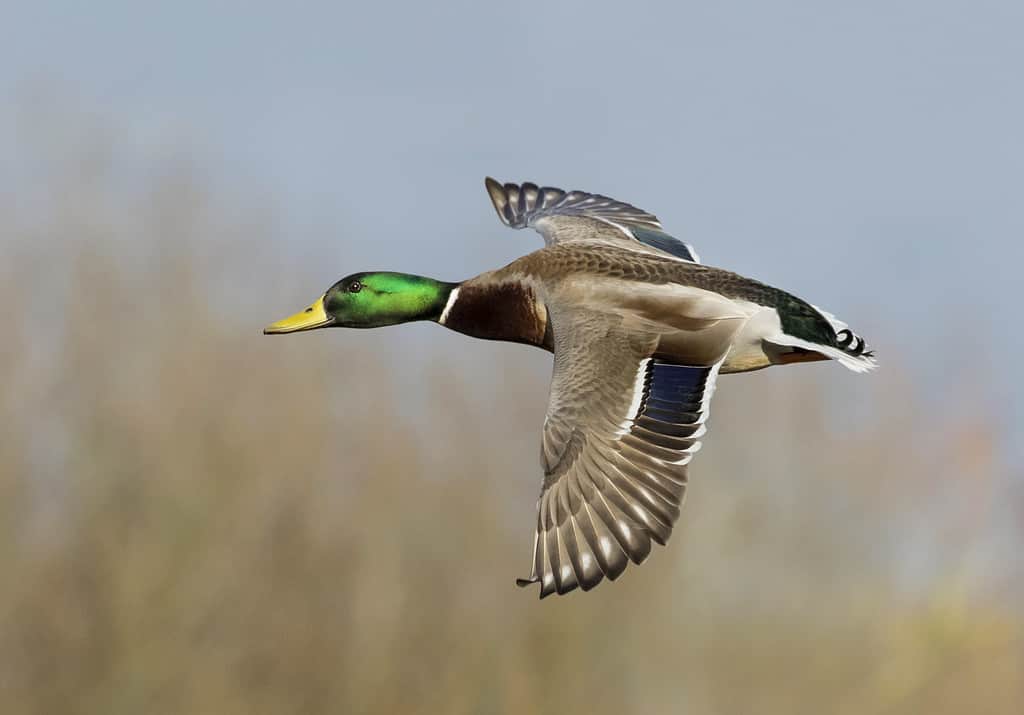
The mallard is thought to be the most abundant duck on Earth.
©steveo73/iStock via Getty Images
Easy to spot near any wetlands, the mallard is the most abundant duck species in North America.
The male mallard is distinguishable with its glossy green head, sharp yellow bill, and narrow white collar. The chest is deep-chestnut-hued, while an assortment of gray characterizes the rest of the body. Females, in contrast, are more subdued in their brownish-gray patterning, aimed at camouflaging against potential predators. The mallard females are known for making the quintessential “quack” of a duck.
They adapt to just about any freshwater habitat – lakes, ponds, marshes, rivers, coastal waters, and even the open sea. True to its adaptable nature, the mallard isn’t picky about its food. They graze on roots, tubers, and seeds but are also comfortable snapping up insects, crustaceans, and even small fish. This varied diet lends it an edge in diverse habitats and fluctuating seasons.
5. The American Black Duck (Anas rubripes)

This duck is the heaviest in the genus
Anas.
©mirceax/iStock via Getty Images
The American black duck is often considered a bit of an enigma. These ducks are elusive and prefer to remain relatively hidden.
American black ducks have very few colors, unlike their more vibrant duck relatives. They’re slightly larger than the mallard, and their plumage is typically darker, hence their name. This color provides them invaluable camouflage among the marsh vegetation or wooded areas where they often reside.
The scenery changes significantly during the breeding season. The males dazzle with their striking purple-green speculum – a stunning contrast to the otherwise somber plumage.
This species lives mainly in the eastern parts of North America up to some regions of Canada. North Carolina to Maine and inland to the Great Lakes are ideal homes for this elusive species. They are year-round residents in these areas, often seeking out smaller, quieter bodies of water.
Their diet includes plant materials, invertebrates, and occasionally small fishes.
6. The Lesser Scaup (Aythya affinis)

With a global breeding population of 3.8 million, the Lesser Scaup is North America’s most abundant diving duck.
©ps50ace/iStock via Getty Images
The lesser scaup is a medium-sized diving duck, also called the little bluebill or broadbill. This species is distinguished by its pebbled appearance in a mix of black, white, and gray. The males present a bluish sheen on their heads, contrasting sharply against their bright yellow eyes and dark bills, tipped with a sooty black. Females, on the other hand, have darker brown plumage and a duller bill color.
The lesser scaup’s diet consists primarily of mollusks and small aquatic plants found in their marine habitats. They are also adept divers and will venture into the depths for food.
One of their unique characteristics is their tendency to form sizeable groups, particularly during migration. These flocks can attain numbers in the tens of thousands, making it harder for predators to pick off individuals.
Lesser Scaups breed in the boreal forests and parklands of North America. In the non-breeding season, they head south for the winter. They sometimes stay along the coastlines between the United States and as far south as central Mexico. During their migration, they are frequently spotted over open waters, like large reservoirs.
7. The Redhead (Aythya americana)

Redheads are well-known for laying their eggs in another duck’s nest and allowing their ducklings to be hatched and nurtured by the other duck.
©Shayne Kaye/iStock via Getty Images
This species is known for its flaming red color on its head and vivid, sunlit yellow eyes. The male redhead showcases a gleaming chestnut-red head and neck, most notable during the breeding season, while its body is a mix of black and gray feathers. The females boast a brownish-gray plumage.
Equipped with a broad bill, redheads are well-acquainted with the art of foraging beneath the water’s surface. They prefer aquatic plants, including pondweeds and wild celery, although their diet can also extend to invertebrates, seeds, and other small aquatic animals when necessary.
Like many other duck species, they usually pick wetlands, preferably with shallow waters. They are widely distributed across the breeding grounds in North America’s prairies, specifically from the eastern Rockies to Manitoba and Minnesota.
During the non-breeding season, while awaiting migration, they flock to larger bodies of water, including estuaries, coastal bays, and even saline lakes. As the winter approaches, redheads fly to the southern regions of North America.
Their distinctive courtship rituals also mark it as a truly unique species. They have an elaborate and animated courtship display centered on vocal calls and a series of postures that manifest their readiness to mate and their genetic strength.
8. The Ring-Necked Duck (Aythya collaris)

Ring-necked ducks pairs stay together only for one breeding season.
©Jeff Edwards/iStock via Getty Images
This North American native species is a medium-sized diving duck with a distinctive silhouette. The ring around its neck is often hard to see despite its name suggesting otherwise.
The males have glossy, black, angular heads, a striking signet of white between their bill and their eyes, and a backside cloaked in gray feathers. Their chest is brilliantly colored, boasting a dark, burnt chestnut. On the other hand, the females have a more subtle attire, predominantly brown and noted for their white eye-ring and a grayish bill.
These ducks live all across North America. They inhabit shallow freshwater ponds, marshes, and creeks in densely vegetated areas. In winter, they make their way south, frequenting more sizable water bodies like lakes and reservoirs, extending as far as Central America.
As diving ducks, this species finds most of its food underwater. They dive frequently, foraging mainly for aquatic invertebrates like crustaceans, insects, and vegetation.
9. The Greater Scaup (Aythya marila)

The greater scaup is larger than the closely related lesser scaup.
©ChristinaPrinn/iStock via Getty Images
The greater scaup, also known as the “bluebill,” stands out among North American ducks due to its distinctive, brilliant blue bill. The males are strikingly elegant in breeding plumage, with a glossy black head, neck, and chest, along with a light gray back and, of course, its flashy blue bill. The females, meanwhile, present more modest coloring, with dark brown plumage, but still share the characteristic blue bill.
Greater scaups are diver ducks skillfully submerging themselves to find their meals. Using their marine-hued solid bills, they dive beneath the water surface and can stay submerged for up to a minute, searching for delectable crustaceans, mollusks, and aquatic plants.
A majority of these ducks live around the Great Lakes region in the winter months. They also cover vast territories and are often seen along saltwater bays and seacoasts in large flocks. In the spring and summer, the greater scaups can nest as far north as the low Arctic tundra regions.
10. The Canvasback (Aythya valisineria)

This species highly resembles the previously mentioned redhead.
©Wirestock/iStock via Getty Images
Canvasbacks are large ducks with distinctive red eyes and long sloping foreheads. Their feathers start with a chestnut-red head and neck, black breast and tail feathers, as well as stunning white feathers on their backs. The canvasbacks are the largest species of diving duck in North America.
These diving ducks are well known for their feeding habits. Like other ducks, they are omnivores, eating insects, plants, and seeds. But they also like to dive deep for their meals. One of their favorite food is plant tubers found at the bottom of lakes and wetlands. This habit ensures they rarely face food scarcity, as most water bodies have plenty of edible plant life and small creatures under the surface.
They are also long-distance migration birds. These strong fliers travel thousands of miles to reach their breeding and wintering grounds, often passing over large water masses without stopping. They inhabit freshwater lakes and marshes all around North America. During the breeding season, they travel to Canada and sometimes to Alaska.
11. The Bufflehead (Bucephala albeola)
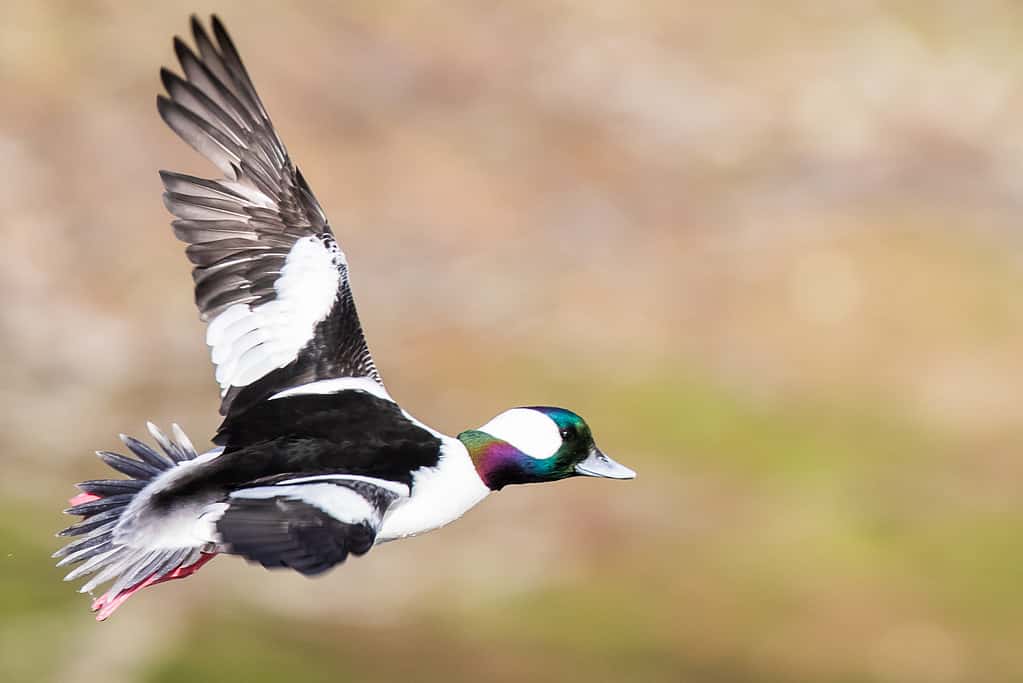
The male bufflehead boasts vibrant feather colors on its head.
©Jeff Huth/iStock via Getty Images
The bufflehead is the smallest sea duck species that graces the North American continent. If you’re wondering about their unusual name, it’s inspired by their rather sizeable, plump head.
Iridescent shades of green and purple adorn the male bufflehead’s head, contrasting with its brilliant white underparts and sides. Its dark back and the defining, prominent white patch on its head give it a unique, recognizable silhouette. The female has gray-brown plumage, petite stature, and a white cheek patch.
Despite its small size, this sea duck can dive as long as 25 seconds. They tend to favor small ponds, lakes, inland wetlands, and coastal estuaries. With a mixed diet of aquatic invertebrates and plant matter, they’ve learned to adapt to what their environment offers.
For breeding grounds, they prefer the boreal forests of Canada and Alaska. Before the winter months, they migrate southward, showing a rather coastal preference, finding their homes from the Pacific and Atlantic coasts down to Northern Mexico.
12. The Common Goldeneye (Bucephala clangula)

Its closest relative is the resembling Barrow’s goldeneye.
©Jeff Kingma/iStock via Getty Images
This species also gets its name from its golden-colored eye. The men, with their gleaming golden eyes, contrast the brilliant white undersides, black wings, and the glossy green-black head. The females’ plumage consists of soft grays and whites with chocolate brown heads and bright yellow eyes.
Primarily a diving duck, the species feeds on a diet rich in aquatic invertebrates and small fish. It can dive capable of diving up to 20 feet to snatch a morsel from the river bed.
Once fall arrives in the northern part of North America, these ducks take flight to the south, seeking warmer climates, usually in the southern parts of the United States.
The common goldeneye displays intriguing behavior during the breeding season. Males throws their head back in an exaggerated display, a part of their unique courtship ritual aimed at enticing a female. Once paired, they nest in tree cavities or nest boxes, often abandoned by the larger woodpecker species.
13. The Barrow’s Goldeneye (Bucephala islandica)

There is also a small population of Barrow’s goldeneye in Iceland.
©Sen Yang/iStock via Getty Images
Boasting a black head with iridescent blue and purple gloss and pearly-white feathers on the body, the male of this species is a sight to behold. The females have a more subdued color with a chocolate-brown head and gray body. But the male’s eye, a piercing golden hue, gave this duck its name.
The Barrow’s goldeneye pairs their impressive diving ability with their knack for foraging underwater. They hunt primarily on mollusks and crustaceans in freshwater environments and tend to switch to more prevailing marine animals like amphipods and isopods when in marine environments.
This species prefers to breed in the Northwestern part of the continent and winter along the Pacific coast, migrating to ice-free waters rich in their preferred food. They favor areas with abundant aquatic vegetation, using the coverage for nesting and protection.
Their habits during mating season are also unique. Males participate in surprising courtship displays, including kicking water, head throws with an accompanying call, and gestures displaying their robust wing muscles, all to win over the females.
14. The Long-Tailed Duck (Clangula hyemalis)
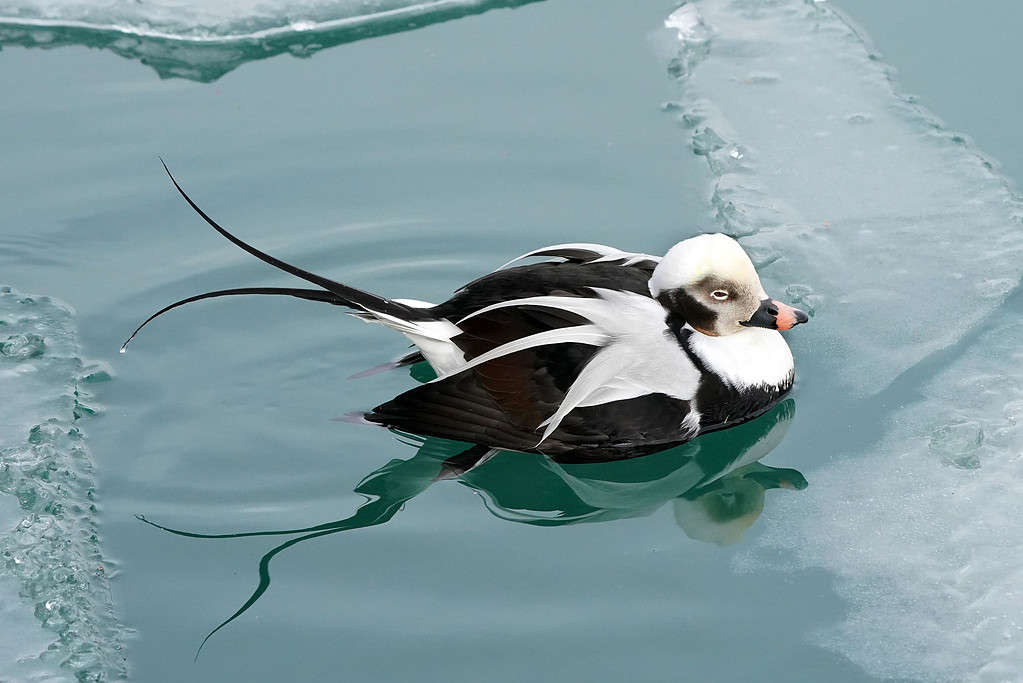
The long-tailed duck is the only member of the genus
Clangula.
©Janet Griffin-Scott/iStock via Getty Images
If you ever get to see the long-tailed duck, it’s a spectacle you’re not likely to forget! Known as masters of deep-diving, these fascinating waterfowl display unparalleled aquatic skills, capable of diving down 200 feet (60 meters) in search of food. This makes them one of the deepest diving ducks in North America.
These ducks are characterized by their striking black and white plumage. But their long tail adorned with black feathers gave the species its name — the long-tailed ducks. You can often spot these nomads of the Arctic in the chillier regions of North America, such as Alaska and Arctic Canada. However, when winter arrives, they venture with flocks of thousands into warmer climates, relocating to the coastal areas of the Pacific and Atlantic Oceans.
The long-tailed ducks are not picky eaters. Their diet consists of a varied mix, including a healthy serving of animal life—such as small fish, mollusks, crustaceans, and also a range of invertebrates. This nutritional variety is likely why they must dive so deep, plunging into the ocean’s depths to catch their lunch.
The breeding process of these deep divers is equally fascinating. Once courtship has taken place, the pairs retreat to land, preferring to nest on dry ground rather than in the water. Their brood comprises around 8 to 9 eggs, which the females incubate. And let’s not forget their unique vocalization. Male long-tailed ducks have a variety of mating calls— one almost sounds like a yodeling laugh!
15. The Harlequin Duck (Histrionicus histrionicus)
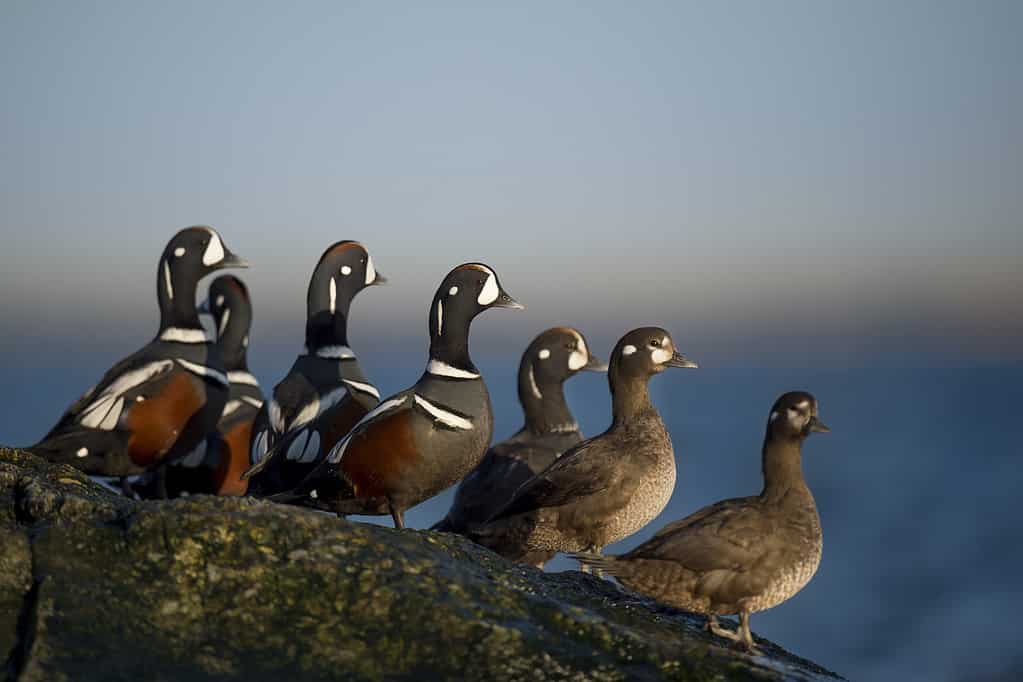
It takes its name from Harlequin, a colorfully dressed character in Commedia dell’arte.
©ps50ace/iStock via Getty Images
This small sea duck is recognizable thanks to its striking color pattern. The males boast an eye-catching array of colors. A deep blue dominates its body, while distinct brown patches, white stripes, and spots glisten against it. The females have a more subdued gray-brown look. In both sexes, however, one can’t miss their compact, heavy body and palmed feet, suggesting a life uniquely attuned to the sea.
Their food preference? Aquatic insects, crustaceans, and small fish that inhabit these waters. Diving and maneuvering through the currents with ease, they showcase impressive agility.
This species lives in the coastal regions, in the fast-flowing rivers and streams of North America’s northern and western parts. In the winter, they venture to sea-facing, rocky shorelines. This migration strategy allows them to benefit from the abundant maritime food resources. Yet, they return to their original riverine habitats when the breeding season start.
16. The Hooded Merganser (Lophodytes cucullatus)

These ducks have an extra eyelid called a “nictitating membrane,” which is transparent and acts like a pair of goggles to protect the eye while swimming.
©gjohnstonphoto/iStock via Getty Images
The hooded merganser is a unique duck that wears what looks like a medieval hood. They feature a crested head, giving it a regal look like donning a fancy feathered hood. The males boast hoods colored in a combination of black and white. Females have a more subdued hood color, usually a warm reddish-cinnamon. On their bodies, they have brown and white feathers.
This duck’s chunky body with a thin neck and short wings is specifically adapted to its diving lifestyle. Even their bills are special – long, thin, and serrated, perfect for snatching aquatic prey. This species’ diet is diverse, with fish, crustaceans, or a host of aquatic insects.
Hooded mergansers prefer a rather solitary lifestyle. They often dwell in small groups or alone and are a shy and elusive species. Unlike many other ducks, hooded mergansers nest in trees, usually in a hole high above the ground or water, to protect their offspring from predators.
Native to North America, they are widespread on a large swath of the continent. They tend to breed in forested areas from Alaska through the northern states and into Canada. Meanwhile, winter often finds them in the southern and coastal United States.
Another unique characteristic is their courtship. The males have an elaborate courtship display worthy of their stunning looks, where they expand their hoods, lower their entire crests to the water’s surface, and emit a frog-like croaking call.
17. The American Wigeon (Mareca americana)
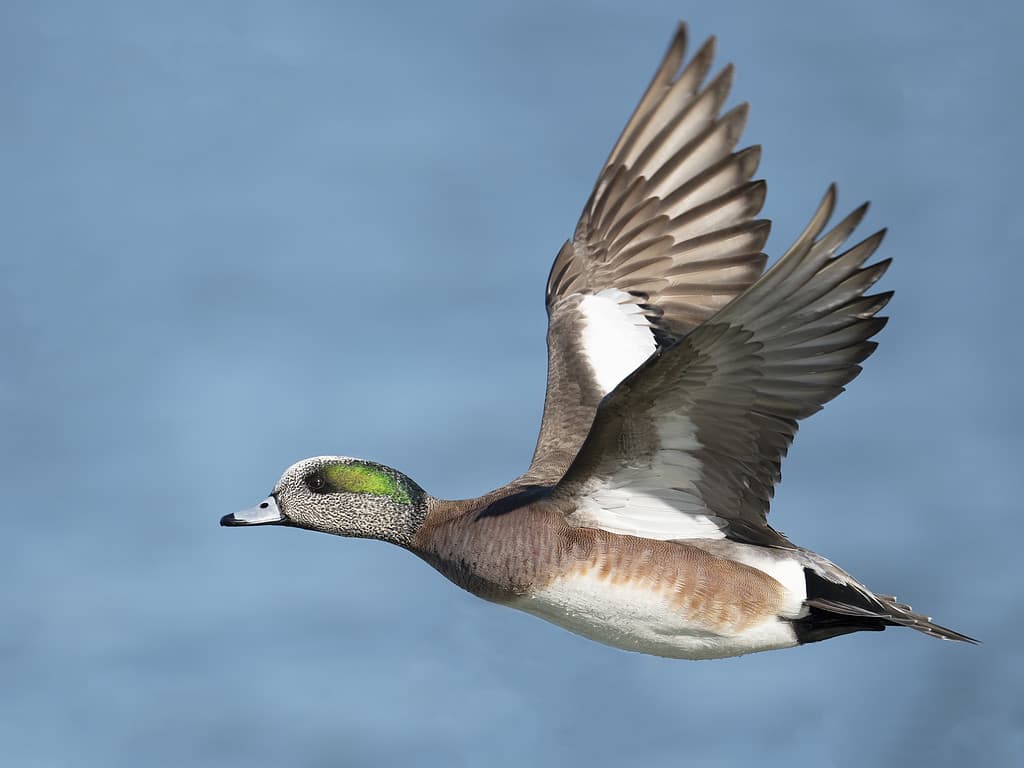
American wigeons have the habit of following other migrating ducks to steal their food.
©BrianEKushner/iStock via Getty Images
The American wigeon is a unique dabbling duck with a lush green and white head and brown feathers on the rest of its body.
Predominantly a bird of open wetlands, the wigeon is known to congregate in large flocks. It is most commonly found in the northern parts of Alaska and Canada during the breeding season, migrating in winter to the southern regions of North America. They prefer to live around grasslands, marshes, and lakes.
This duck is an adept grazer, with almost 90% of its diet comprising plants and seeds. Consequently, their habitat often includes grazing areas close to water bodies. However, the wigeon has an atypical feeding habit. It is often spotted stealing morsels from other ducks, an adaptive behavior that scientists attribute to their shorter necks that limit their own ‘diving’ capabilities.
18. The Gadwall (Mareca strepera)
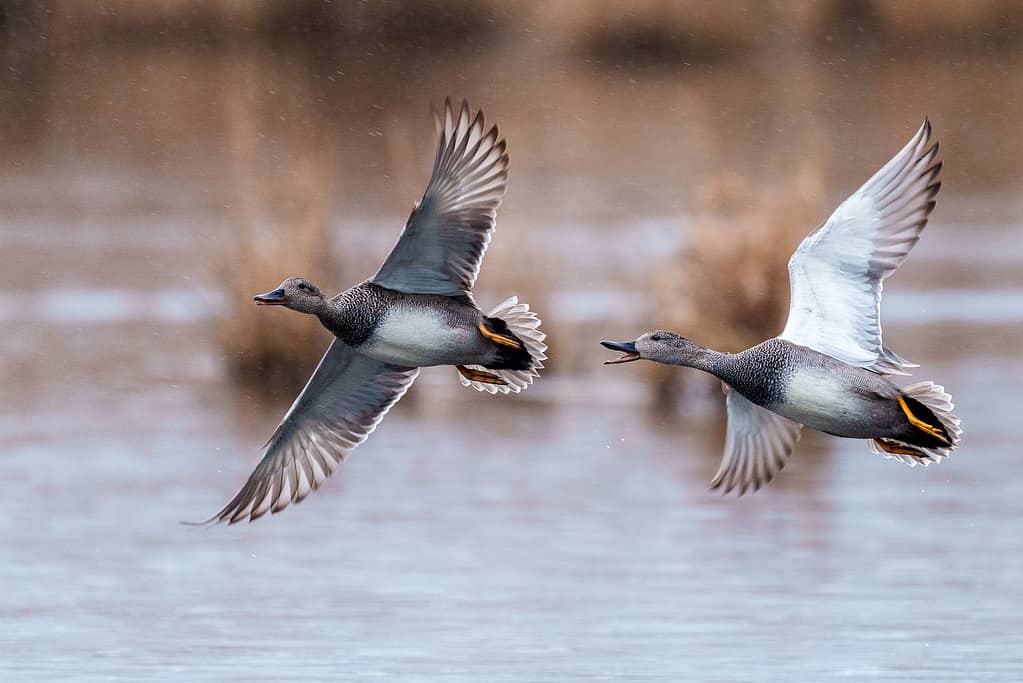
Gadwalls also live on three other continents.
©Wirestock/iStock via Getty Images
Gadwalls are medium-sized ducks. They have brownish-gray feathers with black and white edges. The male gadwall, in particular, hides a remarkable spectrum of colors beneath the brown feathers. An observant bird-watcher might notice the black patch at the rear, the pattern of its chest feathers, and the metallic sheen of the wing feathers that only becomes visible when the wings are spread.
This duck earned its reputation as a camouflage master. The gadwall hides and blends into its surroundings thanks to its hues, making it less noticeable to predators. But it doesn’t stop there. Gadwalls also have a repertoire of disruptive patterns, contrasting colors, and subtle blends to enhance their ability to disguise themselves within their environment.
Gadwalls prefer open wetlands, ponds, and lakes, where aquatic vegetation is available. They can be found from the northern regions of North America down to the central areas, spanning both the East and West coasts and all the way into Mexico. These ducks spend their winters in milder climates as far away as Central America, the Caribbean, and even northern parts of South America.
They thrive on a varied diet of seeds, stems, leaves, and occasional insects.
19. The Black Scoter (Melanitta americana)

The black scoter is the least common of the three scoters.
©BrianEKushner/iStock via Getty Images
The black scoter, a predominantly sea duck, is known to be elusive and a little mysterious. The male is primarily black, a feature that lends the species its name. The distinct knob at the base of the bill in mature males and the stunning golden-yellow bill color play an incredible contrast to the black plumage. Females, on the other hand, adorn a more modest brown color with a dark-colored bill.
Scoters are diving ducks and employ this skill while hunting for food. With a preference for mollusks and crustaceans, these birds will often dive to considerable depths to scour the seabed for these tasty treats. Their unique bill, with sharp edges, works wonderfully to pry their prey from the ocean, lake, or river floors.
These ducks breed in Canada and Alaska’s northern regions. As the winter sets in, they travel southwards towards the milder climates of the coastlines. Consequently, they’re common across the Atlantic and Pacific coasts during these months. But as spring approaches, they travel north again to their breeding grounds.
20. The White-Winged Scoter (Melanitta deglandi)
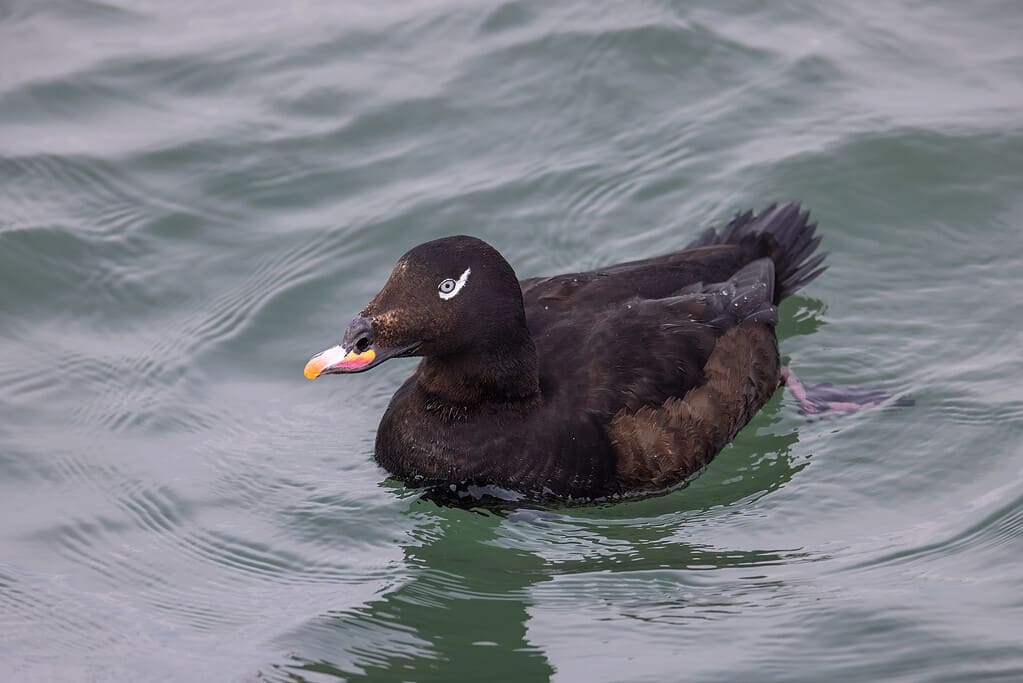
White-winged scoters are among the last ducks to arrive at breeding grounds, and they sometimes don’t start nesting until mid-June.
©Devonyu/iStock via Getty Images
A mature white-winged scoter, the largest of the three North American scoter species, stands distinct with its all-black plumage, contrasting brilliantly with a white patch on its wing. The males exhibit a peculiar characteristic – their bills are swollen at the base with a unique orange shade. The females, smaller and with less color, have brownish bodies and pale cheeks.
As skilled divers, they often delve into the depths of the water to hunt for a feast of mollusks, crustaceans, and small fish. Thanks to their strong bill, they can even consume large mussels and their shells.
This robust, dark-bodied sea duck, with striking white marks on its wings, usually lives in and around freezing waters. The white-winged scoters breed in the subarctic boreal forests of Canada and Alaska. They primarily inhabit inland lakes during the breeding season. When winters arrive, they flock towards the unfrozen coastal waters of the Pacific and Atlantic coasts and the freshwater Great Lakes.
21. The Surf Scoter (Melanitta perspicillata)

After nesting, surf scoters fly to a location where they can shed their flight feathers. They become flightless for a brief period before returning to their wintering zone.
©epantha/iStock via Getty Images
Have you ever spotted a sea duck with a large, multicolored bill? That was likely the surf scoter. Mature males of this species showcase a predominantly black plumage with patches of white on the forehead and the nape. The male’s bill is unique, swollen at the base, and dotted with red, yellow, and white shades. The female, a subdued blend of browns, has a light-colored, slightly upturned bill.
Like most sea ducks, the surf scoter is a benthic feeder — they feast on food found at the bottom of bodies of water. Whether it’s clams, mussels, snails, or even small fish, these ducks are adventurous gourmets and proficient divers. Hard shells don’t deter them, they crush them with their powerful bills. They can dive as deep as 30 feet (9 meters) for 20 to 30 seconds.
Surf scoter spend most of their lives in coastal marine waters, estuaries, and bays, from Alaska to California, and down the Atlantic coast. During the breeding season, they trade saltwater for freshwater, moving to the remote lakes and wetlands of the boreal forest and the Arctic tundra.
22. The Common Merganser (Mergus merganser)

Common mergansers lay clutches of six to 17 eggs. Broods will occasionally form larger groups of 40 or more ducklings.
©Anna39/iStock via Getty Images
This large duck has a unique appearance. Adult males in breeding have a black and white body and a black head with iridescent green feathers. In the non-breeding period, these ducks have a unique reddish-brown head with longer feathers that usually lie smoothly rounded behind their heads. Their bodies display a grayish-white mix of feathers.
The common merganser stands distinct thanks to its unique lifestyle and dietary preference. Its long, slender, serrated bill is designed for snatching its preferred slippery prey — fish, with remarkable precision. Adept at diving, this duck plunges underwater, skilfully maneuvering with its solid and webbed feet to capture fish.
Common mergansers prioritize locations with clear-water rivers and lakes, as murky waters would impair their sight-driven hunting technique. Present predominantly in forested areas of the northern United States and Canada, these birds migrate shorter distances than numerous other duck species.
23. The Red-Breasted Merganser (Mergus serrator)
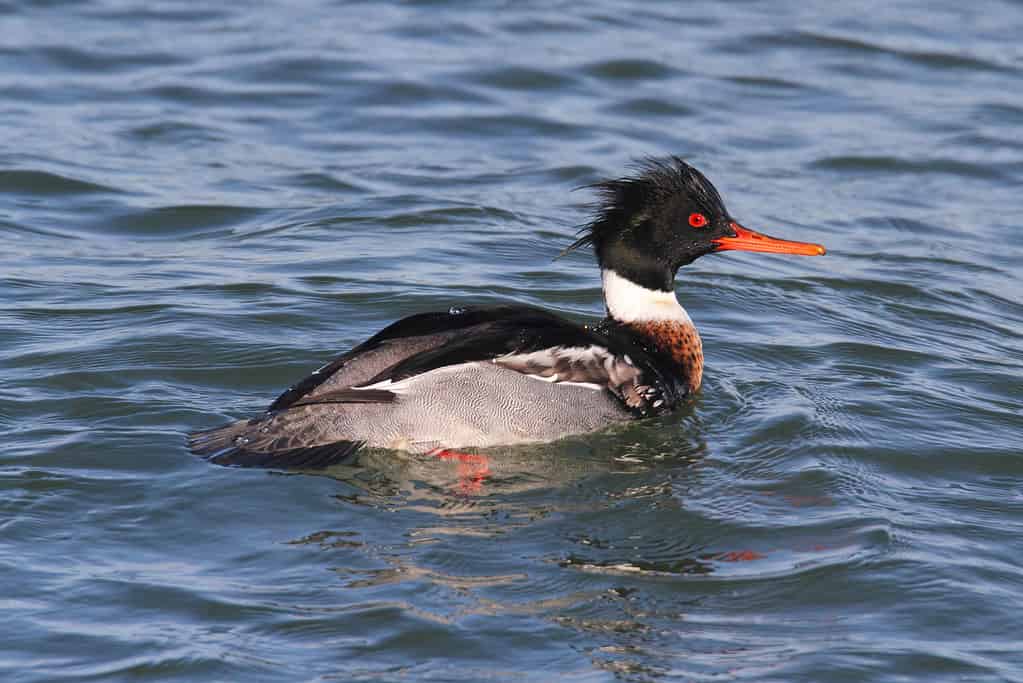
Red-breasted mergansers are among the fastest flying ducks and can fly up to 81 miles per hour.
©SteveByland/iStock via Getty Images
The red breast that gives the species its common name is only displayed by males in breeding plumage. During non-breeding seasons, these ducks display a body with black, gray, and white feathers. A mix of black and long green feathers adorn their heads.
Often spotted on both fresh and salt waters of North America, this duck is notorious for its impressive diving skills. They earned their reputation as diving specialists due to their affinity for subaquatic food hunting. Able to dive as much as 20 feet or more, this species uses its sharp, serrated beaks to clamp down on any slippery prey — usually small fish and invertebrates.
From Alaska, all across the northern United States to Newfoundland in Canada, the red-breasted merganser makes itself at home in diverse environments. When the winter season arrives, they migrate towards warmer areas. Their winter abode ranges from coastal regions, lower-altitude lakes, and rivers to even salt waters of the Pacific down to Baja California and along the Atlantic coast to northern Florida.
This species has unique mating rituals. Males bob their heads and ruffle their feathers, while females respond with inviting gestures. Once paired, they establish nests in sheltered locations on the ground. Instead of being protected and monitored, their offspring are almost immediately independent.
24. The Ruddy Duck (Oxyura jamaicensis)

Ruddy ducks have a unique powder-blue bill.
©Ken Hoehn/iStock via Getty Images
This small, compact duck, prevalent in North America, offers an unexpected color spectacle with its powder-blue bill and chestnut-red bodily plumage. One of the unique aspects of the ruddy duck is its stiff-tailed dabbler. With its tail often cocked straight up, it has a distinctive silhouette, making it easily identifiable, even from afar.
Ruddy ducks have a reputation for being feisty and aggressive, especially during breeding seasons. They can be observed skittering across the water while whistling and bobbing their heads. These vibrant displays are part of their courtship rituals.
As good divers, they feed on aquatic invertebrates, especially during the breeding seasons. They also feed on plant material such as seeds and submerged aquatic vegetation to supplement their diet. They thrive in open water and marshes across North America and prefer wetland habitats, where they can dive to forage.
25. The Common Eider (Somateria mollissima)
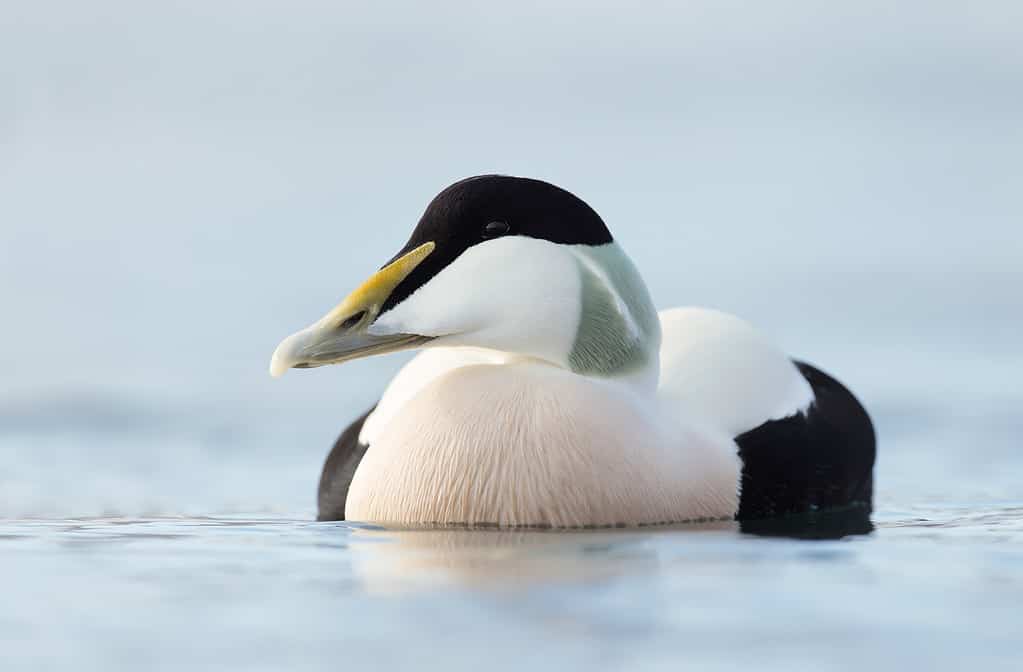
Common eiders swallow their food whole.
©Dgwildlife/iStock via Getty Images
The common wider is North America’s heaviest and largest duck. These ducks adorn dark plumage with pale underparts, and during the breeding season, the characteristic lime green color on the male’s neck and head.
The common eider has a fondness for the colder regions of North America. In summer, they migrate to the Arctic coast, rocky northern shores, and islands for breeding. When the cold shivers of winter set in, they travel southward but still opt for locations with icy, open waters, often choosing coastal areas over freshwater bodies.
They are diving specialists, plunging into chilly oceanic depths to dislodge mussels, clams, sea urchins, and other shellfish from the seabed. Common eiders can dive up to 65 feet underwater and stay submerged for more than a minute while they forage.
26. The King Eider (Somateria spectabilis)

King Eiders often cross-breed with Common Eiders.
©Manakin/iStock via Getty Images
The king eider, named for its majestic appearance, is a large sea duck that lives in North America. This strikingly colored sea duck is incredibly distinguishable, with males showcasing a kaleidoscope of colors. Clad in vibrant black, cream, and green hues with a unique bulbous orange shield on the bill, these ducks are unique. On the other hand, female king eiders display brown feathers and a softer-colored bill.
Like other sea ducks, king eiders have a diet of mollusks, crustaceans, and small fish, essential nutrients for their long-distance travels.
These ducks spend most of the year in coastal marine ecosystems at high latitudes, around the northeast coast of the United States and Canada, as well as the south coast of Alaska. They migrate to the high Arctic tundra to breed in June and July.
Females nest in small depressions on the ground lined with down feathers, hidden away from predators. The dedication of the female towards her eggs is noteworthy, as she never leaves them unattended, surviving on stored body fats while incubating her eggs.
27. The Northern Shoveler (Spatula clypeata)
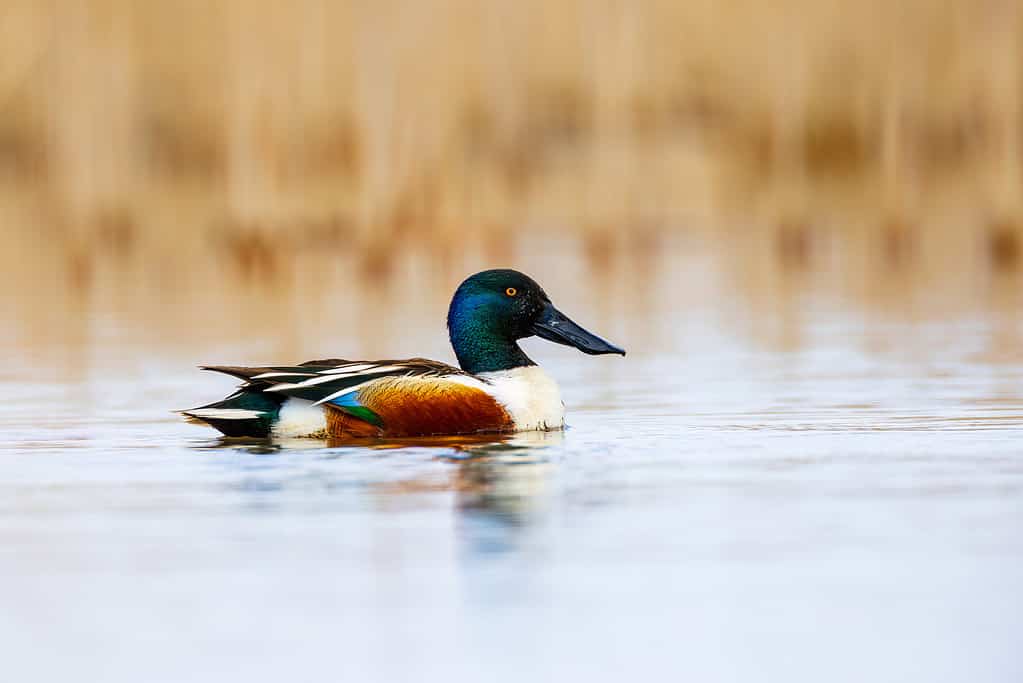
The Northern Shoveler has the largest bill of any North American duck.
©Eric Santin/iStock via Getty Images
The northern shoveler is one of the most widespread ducks. Males stun with their luminous green heads, yellow eyes, and chestnut flanks, while females have warm brown plumes.
This unique member of the duck family stands apart with an oversized, spoon-shaped beak that sets it apart from its peers. Its bill is a tool for sifting through the water and mud to gather tasty morsels. The edges of a shoveler’s bill are lined with over a hundred little ridges or ‘lamellae’, which form a brilliant straining system.
Northern shovelers live in the shallow wetlands of the prairies, the fringes of marshy lakes, or even the brackish marshes along the sea coasts. They’re known to breed across the northern areas of North America, extending from Alaska across to Quebec and southwards down the United States. In the winter, they migrate toward Central America.
This species is also known to be very friendly. These ducks usually form large groups, or ‘rafts’, swimming together in tight formations.
28. The Blue-Winged Teal (Spatula discors)
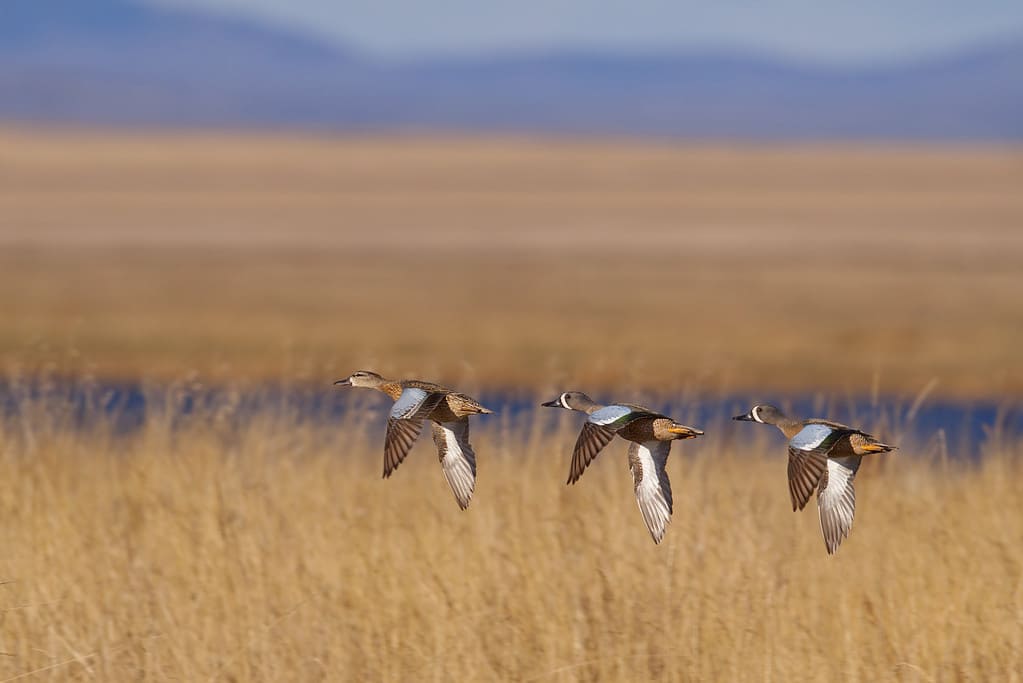
The blue-winged teal is among the last birds to fly north in the spring but among the earliest to return south in the fall.
©Ken Hoehn/iStock via Getty Images
This species is common around any North American wetland. The male is a charming sight, with a slate-gray head and a white crescent in front of the eye, its body in shades of finely patterned brown. The female has unpretentious plumage for effective camouflage. Also, as their name suggests, both genders display bright blue feathers on their wings.
As natural herbivores, their daily diet consists of seeds from sedges, grasses, pondweeds, and smartweeds, coupled with an occasional indulgence in insects and crustaceans.
These ducks are truly at home in the water, favoring bodies of water surrounded by dense, emergent vegetation. Fresh marshes, shallow ponds, and wetlands serve as their primary habitat. But they are also among the first ducks to fly south for the winter. When fall arrives, they set off on migrations all the way to South America in countries like Ecuador, Colombia, or Venezuela.
Summary of the 28 Types of Ducks in North America
| Number | Duck Name | Scientific Name |
|---|---|---|
| 1 | The Wood Duck | Aix sponsa |
| 2 | The Northern Pintail | Anas acuta |
| 3 | The American Teal | Anas carolinensis |
| 4 | The Mallard | Anas platyrhynchos |
| 5 | The American Black Duck | Anas rubripes |
| 6 | The Lesser Scaup | Aythya affinis |
| 7 | The Redhead | Aythya americana |
| 8 | The Ring-Necked Duck | Aythya collaris |
| 9 | The Greater Scaup | Aythya marila |
| 10 | The Canvasback | Aythya valisineria |
| 11 | The Bufflehead | Bucephala albeola |
| 12 | The Common Goldeneye | Bucephala clangula |
| 13 | The Barrow’s Goldeneye | Bucephala islandica |
| 14 | The Long-Tailed Duck | Clangula hyemalis |
| 15 | The Harlequin Duck | Histrionicus histrionicus |
| 16 | The Hooded Merganser | Lophodytes cucullatus |
| 17 | The American Wigeon | Mareca americana |
| 18 | The Gadwall | Mareca strepera |
| 19 | The Black Scoter | Melanitta americana |
| 20 | The White-Winged Scoter | Melanitta deglandi |
| 21 | The Surf Scoter | Melanitta perspicillata |
| 22 | The Common Merganser | Mergus merganser |
| 23 | The Red-Breasted Merganser | Mergus serrator |
| 24 | The Ruddy Duck | Oxyura jamaicensis |
| 25 | The Common Eider | Somateria mollissima |
| 26 | The King Eider | Somateria spectabilis |
| 27 | The Northern Shoveler | Spatula clypeata |
| 28 | The Blue-Winged Teal | Spatula discors |
The photo featured at the top of this post is © mirceax/iStock via Getty Images
Thank you for reading! Have some feedback for us? Contact the AZ Animals editorial team.







